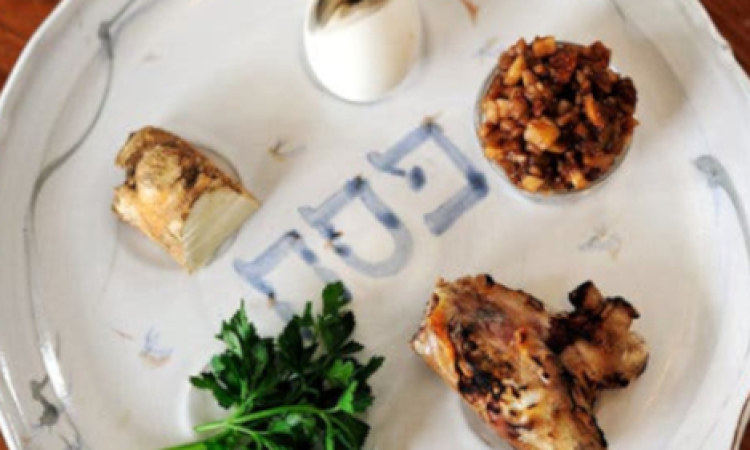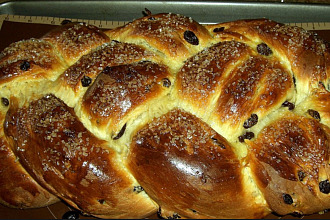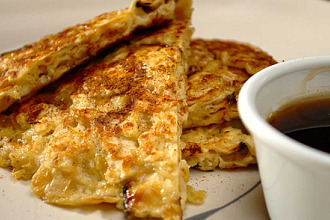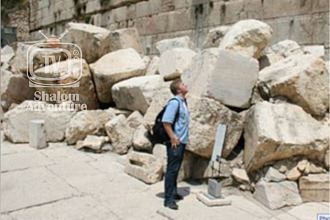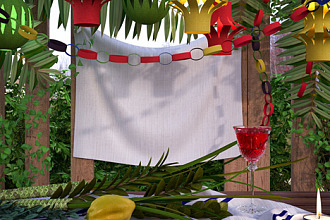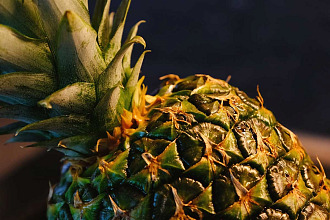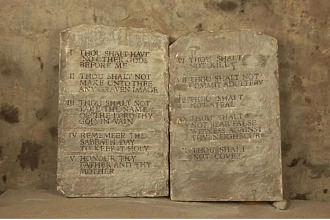MY 98-year-old mother calls my Passover seder a gantzeh megillah — a big production.
She's right. For me, the seder is the hardest event of the year to prepare for. Yet it is by far the most meaningful because it commemorates the defining chapter in Judaism, when the Jews fled slavery in Egypt to freedom in the promised land.
By the time the 40-plus guests arrive at my home in Washington on the evening of April 6 and are seated around the mismatched tables and chairs, I will let out a deep sigh of relief. I will also probably get chills, knowing that I'm following what was written in the Bible more than 2,500 years ago. We may not "eat the flesh that same night, roasted over fire," as the Book of Exodus says, but we still eat unleavened bread, bitter herbs and many other dishes added to the original meal.
I have been the host of this Passover meal for about three decades. I've mixed recipes that we've eaten for years with new ones, like eggs that are covered in sand and baked overnight. I have a gefilte fish party with some friends beforehand. The main course and desserts are on a buffet table. I prepare at least five variations of haroseth, a mixture of sweet fruit and nuts that symbolizes the mortar used for buildings in Egypt. (On Wednesday I will make one of them at the White House.) For the vegetarians at my table I make a vegetarian broth with matzo balls.
My seder survival tactics boil down to a few basics. Make a list. Follow it. Always accept help when offered. And remember to create your own family traditions. With my nine-day Passover countdown plan, you can give a stress-free seder for five or 50. And you can enjoy yourself.
Unlike many practicing American Jews, my husband, Allan, and I have only one formal Passover seder and do not use special dishes. But we remove all leavened products and legumes like beans from our house, and we eat matzo each day. We divide the work: he conducts the seder, buys the wines and gets the gifts for the children who find the afikomen, the hidden matzo; I prepare the food and tables.
The seder plate, holding special foods that are mentioned in the seder service, is a focal point of the table. On our seder plate the horseradish, symbolic of the bitterness of slavery, is served with matzo and haroseths whose recipes I have gathered in my trips around the world. I make versions with chestnuts, dates and cherry preserves, all representing places where Jews wandered in the diaspora. This year I'm using a recipe from a recent visit to Arkansas.
The eggs for the plate — symbolic of the sacrifice in the temple in ancient Jerusalem and of everlasting life — are left in the shell, covered in sand and cooked overnight in a tagine, a recipe I found in a French cookbook with Jewish recipes imported from North Africa. My husband's mother started the formal meal with hard-cooked eggs, serving them peeled and in salt water, an Eastern European custom. I have followed her tradition with my eggs, which come out caramel-colored and creamy.
Then, the gefilte fish, which I make with friends in my kitchen the day before the seder at our annual "gefilte fish-in." My friends bring their own pots and their own mix of whitefish, pike and carp, and onions and carrots. We grind the fish and the onions in my KitchenAid mixer and cook them in six separate pots. With the fish I always serve homemade horseradish sauce; the root holds a place of honor in my garden. Sometimes a guest will bring great horseradish from New York, ground on the Lower East Side; this year I am using a recipe from Kutsher's Tribeca.
For the children, the most welcome dish is the chicken soup with matzo balls. My matzo balls, neither heavy as lead nor light as a feather, are al dente, infused with fresh ginger and nutmeg. This year, with so many guests, I will freeze them, and the soup, in advance.
On the buffet is either brisket with lots of onions, carrots and wine, or one made with preserved lemon and tomato. There is also roasted chicken with fennel for those who don't want red meat. With the meat I always serve a spring vegetable like asparagus in an orange mayonnaise that a friend brings, as well as other make-ahead dishes like roasted red-pepper salad, roasted beet salad and, lately, quinoa with vegetables. I have been omitting kugel — too heavy.
For dessert, I have a buffet of Passover chocolate roll, lemon torte, strawberries and a compote with chremsel, a fritter filled with nuts and dried fruit that my father loved when he was growing up in Germany.
Like everything in Judaism, our seder evolves each year and the props seem to pile up. A few years ago we added an orange to our seder plate, symbolizing that a woman, too, can lead a seder. I also have a collection of plastic frogs and snakes to throw when the plagues are mentioned. When we sing the Passover song "Dayenu," I give everyone a scallion, and we playfully hit each other to act out a Persian custom that symbolizes the sting of the whip from Egyptian taskmasters.
But what makes our seder so special is not the food, nor the discussion. It is our improvised Passover play, which we perform. It is the story of the Exodus set in a contemporary context. One year it was "reported" by a journalist on the scene in Egypt as the Red Sea was parting. Each year, we have baby Moses, grown-up Moses and lots of sheep. The casting is open; anyone can be a star.
Here's the Passover countdown:
NINE DAYS AHEAD (Wednesday)
Start spring-cleaning your house if you haven't done it yet.
Get organized. Make a list of what you need for the table and take inventory of silver, china and tablecloths. If you don't have enough, borrow, buy or rent more.
Check your song sheets and Haggadot (the narration of the story of the Exodus), ordering more online if needed. You will also need a seder plate, a matzo cover and a special cup for Elijah the Prophet. You can buy or make any of these.
Determine how many people are coming, and assign them dishes or jobs. People want to help.
Write out your menu and the ingredients needed for the seder plate (matzo, bitter herbs, haroseth, egg, greens and a roasted lamb shank bone).
EIGHT DAYS AHEAD
Call your kosher butcher, if you are using one, to order the meat.
Visit a Jewish grocery store or a market with a substantial Jewish food section, even if just to see what it has that is traditional for Passover. Before everything is gone, start shopping and storing goods.
Order your fish for gefilte fish.
Buy wine, remembering sweet wine for those who like it and grape juice for the children. Don't forget that there are four cups of wine, symbolizing the four divine promises of redemption, plus Elijah's cup, which we like to believe miraculously empties during the service.
Go online (or visit a Judaica shop) to buy your Passover props if you don't already have them.
Make a tentative seating plan.
SEVEN DAYS AHEAD
If doing the seder for the first time, you may want to test any unknown recipes by making them for Sabbath dinner.
SIX DAYS AHEAD
Do nothing. This is the day of rest. You will need it.
FIVE DAYS AHEAD
Clean your kitchen. I do a spring-cleaning of shelves, drawers and all surfaces. Other people go as far as covering all of their counters or even having two different kitchens.
Buy your ingredients for chicken soup and brisket. Make them and refrigerate overnight.
Prepare your matzo ball mix and refrigerate overnight.
FOUR DAYS AHEAD
Skim the fat off the brisket. Cut the brisket on the bias and freeze it in a casserole that you can bring to the table.
Skim the fat off the chicken soup; save it for the matzo balls. Then freeze the broth.
Make your matzo balls and freeze them on a cookie sheet. Then toss them into a Ziploc bag in the freezer.
THREE DAYS AHEAD
Make your haroseth.
Make a compote if you are serving one and refrigerate.
Roast the shank bone, a symbol of paschal sacrifice, for the seder plate. I put it on aluminum foil in the toaster oven, set on broil so it burns. Freeze it in the foil.
Make your horseradish sauce, either from store-bought horseradish or from the roots in your garden. Make sure you wear goggles and gloves when grinding fresh horseradish.
TWO DAYS AHEAD
Remove anything that contains yeast, flour, leavening or legume products, depending on your custom. I leave these items in bins covered in tape, put them in the garage or give them away. I used to let my children play a game of finding and discarding items that were forbidden for Passover.
Make desserts, freezing or refrigerating as needed.
Finish your grocery shopping.
Set the table, placing the Haggadot at each setting or at every other setting.
Finish your seating chart and write out place cards.
ONE DAY AHEAD
Make gefilte fish.
Boil asparagus, make salad dressing, wash and dry lettuce for salads, blanch vegetables.
Buy flowers.
Start defrosting brisket and soup.
Make cooked vegetable dishes.
Bake your eggs overnight.
DAY OF THE SEDER
Assemble your seder plate.
Peel all the eggs except one, letting them rest in salted water. Light a match under the unshelled egg to make it look as if it is burned, a symbol of the destroyed temple.
Pile matzo on plates and put three in a matzo cover, break one in half and hide the other piece, the afikomen.
Set out Elijah's cup and fill it halfway with wine.
Assemble props for the plagues.
Make last-minute dishes like chremsel.
Start reheating brisket and soup.
Get dressed, take a deep breath, greet your guests and enjoy.
Originally from here
Posted on Shalom Adventure by: Barbara Zaremsky

